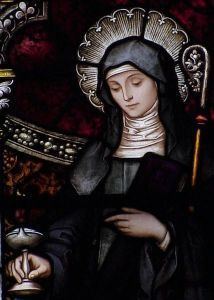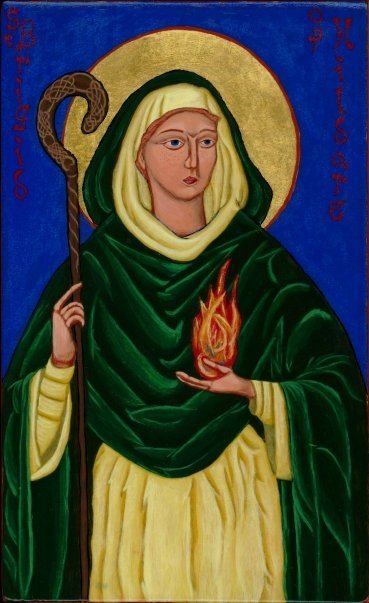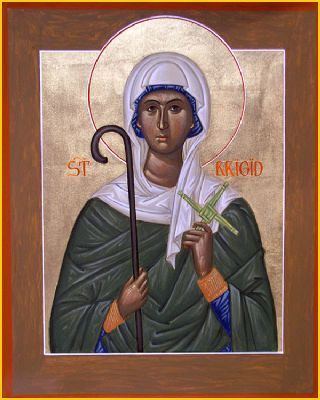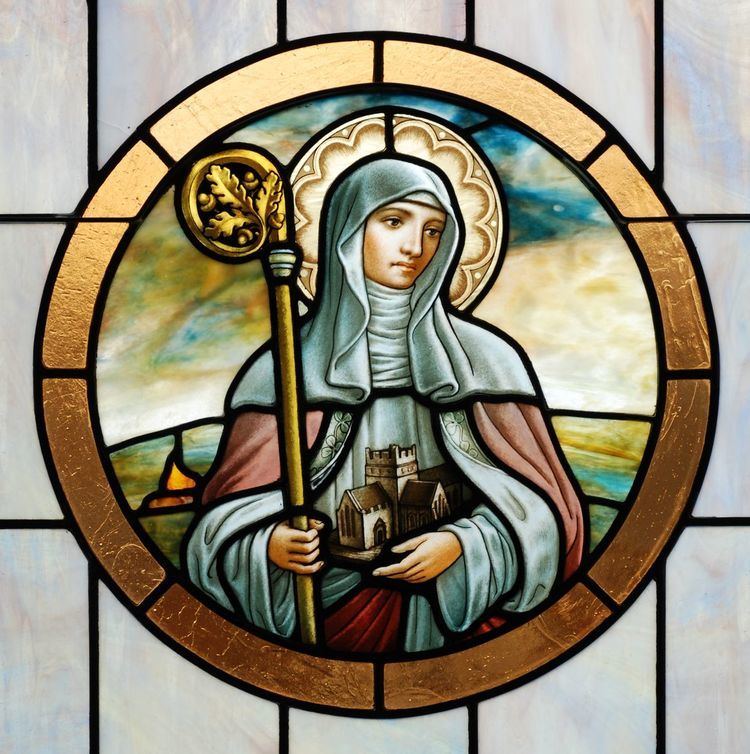Feast 1 February | Name Brigit Kildare | |
 | ||
Venerated in Roman Catholic ChurchEastern Orthodox ChurchAnglican Communion Patronage babies; blacksmiths; boatmen; brewers; cattle; chicken farmers; children whose parents are not married; children with abusive fathers; children born into abusive unions; Clan Douglas; dairymaids; dairy workers; fugitives; infants; Ireland; Leinster, mariners; midwives; milk maids; nuns; poets; poor; poultry farmers; poultry raisers; printing presses; sailors; scholars; travellers; watermen | ||
St brigid of kildare
Saint Brigid of Kildare or Brigid of Ireland (Irish: Naomh Bríd; Latin: Brigida; c. 451 – 525) is one of Ireland's patron saints, along with Patrick and Columba. Irish hagiography makes her an early Irish Christian nun, abbess, and foundress of several monasteries of nuns, including that of Kildare in Ireland, which was famous and was revered. Her feast day is 1 February, which was originally a pagan festival called Imbolc, marking the beginning of spring. Her feast day is shared by Dar Lugdach, whom tradition says was her student and the woman who succeeded her.
Contents
- St brigid of kildare
- Saint Brigid of Kildare 20
- Name
- Historicity
- Life
- Early life
- Religious life
- Miracles associated with Brigid
- Veneration
- Relics
- Iconography
- Placenames
- Other
- References

The saint shares her name with an important Celtic goddess and there are many legends and folk customs associated with her. Some scholars suggest that the saint is merely a Christianization of the goddess. Others suggest that she was a real person who took on the goddess's attributes.
Saint Brigid of Kildare 2.0
Name

The saint has the same name as the goddess Brigid, derived from the Proto-Celtic *Brigantī "high, exalted" and ultimately originating with Proto-Indo-European *bʰerǵʰ-. In Old Irish her name was spelled Brigit and pronounced [ˈbʲrʲiɣʲidʲ]. In Modern Irish it was spelled Briġid / BrighidBride and she is sometimes known as Mary of the Gael. In Welsh she is called Ffraid (lenited to Fraid), as in several places called Llansanffraid, "St Brigit's church").
Historicity
There is some debate over whether St Brigid was a real person. She has the same name, associations and feast day as the Celtic goddess Brigid, and there are many supernatural events, legends and folk customs associated with her.

Some scholars suggest that the saint is merely a Christianization of the goddess. Others suggest that she was a real person who took on the goddess's attributes. Medieval Art Historian Pamela Berger argues that Christian "monks took the ancient figure of the mother goddess and grafted her name and functions onto her Christian counterpart." Professor Dáithí Ó hÓgáin and others suggest that the saint had been chief druidess at the temple of the goddess Brigid, and was responsible for converting it into a Christian monastery. After her death, the name and characteristics of the goddess became attached to the saint.
Life

Probably the earliest biography (Life or Vita) of St Brigid is that by St Broccán Clóen (d. 650). A second Life was written by Cogitosus, a monk of Kildare in the eighth century, and is a fine example of Irish scholarship in the mid-eighth century. The Life attributed to Coelan dating ca. 625, derives further significance from the fact that a forward was later added to it by St Donatus, also an Irish monk, who became Bishop of Fiesole in 824. St Donatus refers to earlier biographies by St Ultan and St Aileran. These differing biographies, giving conflicting accounts of her life, have much literary merit in themselves.

In the controversy about the historical existence of Brigid that erupted in the last third of the 20th century, researchers noted that eleven people with whom Brigid is associated in her Lives are independently attested in annalistic sources, sources that place her death at AD 523 (in the Annals of Tigernach and Chronicon Scotorum) and her birth at 451 (calculated from the alleged age of 72 at death).
Early life
Brigid was born in the year 451 AD in Faughart, Dundalk, Ireland, County Louth. Because of the legendary quality of the earliest accounts of her life, there is much debate among many secular scholars and even Christians as to the authenticity of her biographies. Three biographies agree that her mother was Brocca, a Christian Pict and slave who had been baptised by Saint Patrick. They name her father as Dubhthach, a chieftain of Leinster.
The vitae say that Brigid's mother was a slave and that Dubthach's wife forced him to sell her to a druid when she became pregnant. Brigid herself was born into slavery. From the start, it was clear that Brigid was holy. When the druid tried to feed her, she vomited due to his impurity. A white cow with red ears appeared to sustain her instead. As she grew older, Brigid performed many miracles, including healing and feeding the poor. According to one tale, as a child, she once gave away her mother's entire store of butter. The butter was then replenished in answer to Brigid's prayers . Around the age of ten, she was returned as a household servant to her father, where her habit of charity also led her to donate his belongings to anyone who asked. In two Lives, Dubthach was so annoyed with her that he took her in a chariot to the king of Leinster to sell her. While Dubthach was talking to the king, Brigid gave away his jewelled sword to a beggar to barter it for food to feed his family. (The kingame wouldn't have been angry? E.D) The king recognized her holiness and convinced Dubthach to grant his daughter her freedom.
Religious life
It is said that Brigid was "veiled" or received either by St. Mac Caill at Croghan, or by St. Mél of Ardagh at Mág Tulach (the present barony of Fartullagh, County Westmeath), who also granted her abbatial powers. It is said that in about 468, she and St. Maughold (Macaille) followed St. Mél into the Kingdom of Tethbae, which was made up of parts of modern Counties Meath, Westmeath and Longford.
According to tradition, around 480, Brigid founded a monastery at Kildare (Cill Dara, "church of the oak"), on the site of an older pagan shrine to the Celtic goddess Brigid, served by a group of young women who tended an eternal flame. The site was under a large oak tree on the ridge of Drum Criadh. Brigid, with an initial group of seven companions, is credited with organizing communal consecrated religious life for women in Ireland. She founded two monastic institutions, one for men, and the other for women, and invited Conleth (Conláed), a hermit from Old Connell near Newbridge, to help her in Kildare as spiritual pastor of them. It has often been said that she gave canonical jurisdiction to Conleth, Bishop of Kildare, but Archbishop Healy says that she simply "selected the person to whom the Church gave this jurisdiction", and her biographer tells us distinctly that she chose Saint Conleth "to govern the church along with herself". Thus, for centuries, Kildare was ruled by a double line of abbot-bishops and of abbesses, the Abbess of Kildare being regarded as superior general of the monasteries in Ireland. Her successors have always been accorded Episcopal honour. Brigid's small oratory at Kildare became a center of religion and learning, and developed into a cathedral city.
Brigid is also credited with founding a school of art, including metal work and illumination, which Conleth oversaw. The Kildare scriptorium made the Book of Kildare, which drew high praise from Gerald of Wales (Giraldus Cambrensis), but which has disappeared since the Reformation. According to Giraldus, nothing that he had ever seen was at all comparable to the book, every page of which was gorgeously illuminated, and he concludes by saying that the interlaced work and the harmony of the colours left the impression that "all this is the work of angelic, and not human skill".
The Trias Thaumaturga says that Brigid spent time in Connacht and founded many churches in the Diocese of Elphin. She is also said to have visited Longford, Tipperary, Limerick, and South Leinster. Her friendship with Saint Patrick is noted in the following paragraph from the Book of Armagh: "inter sanctum Patricium Brigitanque Hibernesium columpnas amicitia caritatis inerat tanta, ut unum cor consiliumque haberent unum. Christus per illum illamque virtutes multas peregit", or Between St Patrick and Brigid, the pillars of the Irish people, there was so great a friendship of charity that they had but one heart and one mind. Through him and through her Christ performed many great works.
When dying, St. Brigid is said to have been given the last rites by St. Ninnidh. Afterwards, he reportedly had his right hand encased in metal so that it would never be defiled, and became known as "Ninnidh of the Clean Hand". Tradition says she died at Kildare on 1 February 525.
St. Brigid is said to have had a female companion named Dar Lugdach, a younger nun whom she shared her bed with. According to tradition, Dar Lugdach succeeded Brigid as abbess of Kildare and, as foretold by Brigit, she died exactly one year after her. The two thus share the same feast day. The name Dar Lugdach (also spelled Dar Lugdacha or Dar Lughdacha) means "daughter of the god Lugh".
Miracles associated with Brigid
Brigid is celebrated for her generosity to the poor. In her case, most of the miracles associated with her relate to healing and household tasks usually attributed to women.
Veneration
Brigid is said to have been buried at the right of the high altar of Kildare Cathedral, and a costly tomb raised over her "Adorned with gems and precious stones and crowns of gold and silver". Over the years her shrine became an object of veneration for pilgrims, especially on her feast day, 1 February. About the year 878, owing to the Scandinavian raids, Brigid's purported relics were re-buried in the tomb of Patrick and Columba. In 1185, John de Courcy had their purported remains re-buried in Down Cathedral.
In modern Ireland, "Mary of the Gael" remains a popular saint, and Brigid remains a common female Christian name.
Relics
A skull said to be Brigid's has been preserved in the Igreja São João Baptista (Church of St. John the Baptist) in Lumiar in Portugal (38°46′29″N 9°09′54″W.) (near the Lisbon airport) since 1587 and is venerated on 2 February (not 1 February, as in Ireland). St Brigid's head was reputedly carried to King Denis of Portugal in 1283 by Irish knights travelling to the Aragonese Crusade. According to Denis Murphy, when the relics of the saints were destroyed, in the sixteenth century, during the deputyship of Lord Leonard Gray, Brigid's head was saved by some of the clergy, who took it to the Neustadt, in Austria. In 1587 it was presented to the church of the Society of Jesus in Lisbon, by Emperor Rudolph II.
The inscription on the tomb in Lumiar reads: "Here in these three tombs lie the three Irish knights who brought the head of St. Brigid, Virgin, a native of Ireland, whose relic is preserved in this chapel. In memory of which, the officials of the Altar of the same Saint caused this to be done in January AD 1283."
A fragment of this skull was brought to St Brigid's Church, Kilcurry, Dundalk in 1905 by Sister Mary Agnes of the Dundalk Convent of Mercy and in 1928 another fragment was sent by the Bishop of Lisbon to St Brigid's church in Killester, in response to a request from Fathers Timothy Traynor and James McCarroll.
At Armagh there was a "Templum Brigidis"; namely the little abbey church known as "Regles Brigid", which contained some relics of the saint, destroyed in 1179, by William FitzAldelm.
Iconography
In liturgical iconography and statuary Saint Brigid is often depicted holding a reed cross, a crozier of the sort used by abbots, and a lamp. Early hagiographers portray Saint Brigid's life and ministry as touched with fire. According to P.W. Joyce, tradition holds that nuns at her monastery kept a sacred eternal flame burning there. Leitmotifs, some of them borrowed from the apocrypha such as the story where she hangs her cloak on a sunbeam, are associated with the wonder tales of her hagiography and folklore. In her Lives, Saint Brigid is portrayed as having the power to multiply such things as butter, bacon and milk, to bestow sheep and cattle and to control the weather. Plant motifs associated with St Brigid include the white Lilium candidum popularly known since medieval times as the Madonna Lily for its association with the Virgin Mary, and the Winflower Anemone coronaria, called the "Brigid anemone" since the early 19th century. Kildare, the church of the oak Quercus petraea, is associated with a tree sacred to the druids. Her colour, white, was worn by the Kildare United Irishmen during the 1798 rebellion and is worn by Kildare sports teams.
Placenames
Kilbride is one of Ireland's most widely found placenames, there are 43 Kilbrides located in 19 of Ireland's 32 counties: Antrim (2), Carlow, Cavan, Down, Dublin, Galway, Kildare, Kilkenny (3), Laois, Longford, Louth, Mayo (5), Meath (4), Offaly (4), Roscommon (2), Waterford, Westmeath (2), Wexford (4), and Wicklow (8) as well as two Kilbreedy’s in Tipperary, Kilbreedia and Toberbreeda in Clare, Toberbreedia in Kilkenny, Brideswell Commons in Dublin, Bridestown and Templebreedy in Cork and Rathbride and Brideschurch in Kildare. Similarly, there are a number of placenames derived from Cnoic Bhríde ("Brigit's Hill"), such as Knockbridge in Louth and Knockbride in Cavan. In Wales, the villages of Llansantffraid-ym-Mechain, Llansantffraed and Llansantffraid, Ceredigion are named after her; "llan" meaning "church of" and "Ffraid" or "Ffraed" being the Welsh for "Bride".
Other
The artwork The Dinner Party features a place setting for Saint Brigid.
